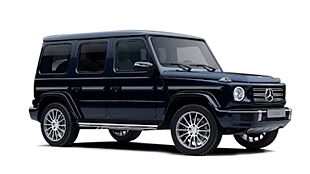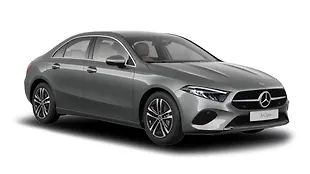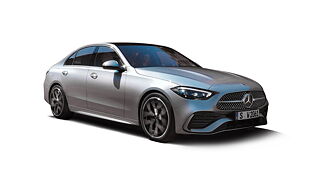Introduction

There was a time when buyers used to opt for diesel cars over petrol models considering the price of diesel to be lower than petrol. However, this trend will slowly diminish with the constant narrowing of the price difference between diesel and petrol.
The importance of having diesel cars is still considered economical by many and diesel cars still do enjoy a good demand. The disparities in petrol and diesel will reduce, but that altering the sentiments in coming times still seems to be a distant possibility. So keeping this thought aside, we reviewed the diesel version of the Mercedes-Benz C-Class - C220 CDI. This is the latest iteration of the C-Class, the petrol variant of which was launched in November last year.
We were impressed with the petrol model, but will the oil-burner walk in its other sibling’s footsteps ? Let’s find out.
Looks

I can argue with anyone who doesn't agree that this C-Class closely resembles the S-Class in terms of aesthetic makeover, styling and the updates. Not that I am complaining about it, but there will also be some guys who will talk about ‘whatever happened to originality?’. Yes, the C-Class does impersonate the big brother and I don't find any problem, especially when the outcome is something like this! The premium and classy feel from the S-Class has been carried over to the C-Class, though the C-Class still has a character of its own. Cosmetically, this diesel variant is same as the one in petrol guise apart from the badging at the back.

This new generation of the new C-Class features a long bonnet that merges into the twin-slat grille with the three-point star at the centre. The fascia with LED headlamps, a low stance and short front overhangs gives the car a menacing look and further enhance the sporty character though the styling is inclined more towards the premium side. While the side profile carries forward the company’s new design philosophy, the tail lamps, rear bumper, boot lid and rear bumper are an imitation of the S-Class. This is something that seems like a direct replica of the S-Class rear which could have been tweaked a bit more to set it apart from the elder sibling.

Interior

The interior of the new C-Class is inspired by the Mercedes-Benz S-Class and offers excellent cabin space and is big on the features list. Though the layout of the new car's interior is similar to that of the previous sedan, the company’s new design philosophy is clearly reflected in the overall design. The creature comforts that come as standard include a new bigger tablet-like screen, latest version of the COMAND infotainment system, a new interface design with a touchpad, climate control and panoramic sliding sunroof. This infotainment system integrates a Garmin navigation system with 3D-visualisation, which we couldn't test thoroughly, but it did the job quite effortlessly for the time we used it. At the start one might take some time to get used to the new touch panel, but it gives a new and pleasant feel after sometime. However, for those who wouldn’t prefer the touch pad, the traditional methods of control are still as easy as they were to operate earlier.

With a wheelbase of 2840mm, the vehicle's interior is spacious with way more space for the rear passengers compared to any of the previous iterations. They get individual temperature zones to set the temperature according to the occupant’s needs. These rear seats also get a 60:40 split which adds to the car’s practicality. With the increase in overall length, the boot space also has increased to 480-litres, which is on par with its rivals.

The adequate amount of leather on the dashboard, steering wheel, gear knob and the seats gives a nice and smooth feel. The gauges are partially digital and feature a large central display which shows most of the options of the car clearly. The cabin also features three colour ambient lighting, a reversing camera that gives a sufficiently wide view of the back, keyless go starting function and an illuminated boot.

Engine

This diesel version is powered by a 2.1-litre turbocharged diesel mill that produces 170bhp of power and 400Nm of torque. The power is transmitted to the rear wheels via the seven-speed dual-clutch automatic transmission.
The previous C-Class car didn’t have any driving modes at all and this is the first edition that gets four new modes - eco, comfort, sport and sport plus. Each mode modulates the functioning of AC, engine start-stop function and power steering, apart from the engine mapping and gearshifts. In the eco mode, the engine start-stop function is on by default and the AC switches off whenever the car stops. The steering is light, gears shift at around 1,800rpm and it does take a couple of seconds to shift up or down.

However, this gets better in the comfort mode and gear shifts happen at around 2,000rpm. Depending upon the throttle input, the gears change quickly and the transformation is smooth. In the sport and sport plus mode, the considerable difference is easily recognised as most importantly its affects the gearbox and steering. The engine also becomes more responsive. In the sport mode, gear shifts are made at 3,000rpm, while in the sport plus mode, they go up to the red line. It is this mode where the optimum amount of power of the mill is delivered.
The car is capable of cruising at 80kmph at 1100-1200rpm in the seventh gear which should give you an idea of what good fuel economy figures we can expect. One can comfortably cruise at 120kmph at 1800rpm, which again tells that the car is really very fuel efficient. The ratios are too good to be perfect and the seven-speed dual-clutch automatic gearbox makes a lot of difference to the comfortable driving experience in the car.

Unlike the rest of the car, the engine hasn’t changed – it is the same unit that powered the previous generation model apart from doing duty for the E-Class and on even lower MFA models in different state of tunes. It does well enough for the ‘all-new’ car; and performs satisfactorily on all fronts including refinement, power and efficiency.
Despite being a diesel variant, the C220 CDI surprisingly doesn’t have the typical diesel clutter, the noise is negligible and the car is very silent. I will appreciate Mercedes-Benz and their engineers for incorporating this tried-and-tested engine in such a brilliant way.

Ride & handling

The new C-Class is based on the company's new lightweight MRA (Modular Rear-wheel-drive Architecture) platform. The sedan is 95mm longer, 40mm wider and 5mm shorter than its predecessor. It now measures 4686mm in length, 1810mm in width and 1442mm in height. The changes made to the car have made a considerate difference, more of an improvement from the previous iterations of the car.
Well, there is a bit of body roll, but it is not noticeable unless you are really pushing the car too hard. It does become elaborate at very high speeds in corners, but that is not really the kind of driving conditions one sees every day in a diesel luxury sedan. Also miss adventures don’t cost too much as the electronics kick in quickly and stabilise the car. It still scores decently in the handling department till the time you aren’t trying anything fancy or overtly aggressive. And the best part is the new power steering, on which we showered tons of compliments when we reviewed the petrol version. In the eco and comfort mode the steering is light, the steering gets hard in the sport and sport plus modes, giving the right amount of feedback.
Talking about comfort, the ride is moderately soft, and gives a very pleasant and cozy feel at very slow speeds and high speeds. But the ride seems not that smooth at speeds that one would generally drive in the city. The ride here feels firm and thuds over potholes and speed breakers percolate into the cabin. Even then compared to the previous car, the overall ride quality has improved significantly. The ground clearance of the car is also surprisingly good for the Indian road conditions. We never scraped the underbody of the car even when we went over some bad patches of roads.

Verdict

Though the diesel mill in this sedan is an old tried-and-tested engine, it is a justifiable one as it provides the right amount of refinement and performance required in the new C-Class.
This 2015 Mercedes-Benz C220 CDI is currently being imported to India but will soon be locally assembled at their plant in Maharashtra. The local production will bring down the price of the car that currently costs Rs 42.90 lakh (ex-showroom). Due to CBU imports, the C-Class costs lot more than the Audi A4 and BMW 3 Series, by the time you get the delivery.
However, the newest entrant also offers a lot more compared to its rivals in terms of features, space and luxury, justifying the extra price.


![Mercedes-Benz C-Class [2014-2018] Image Mercedes-Benz C-Class [2014-2018] Image](https://imgd.aeplcdn.com/272x153/cw/ec/18473/MercedesBenz-CClass-Exterior-130762.jpg?wm=0&q=80)
























